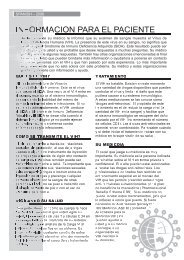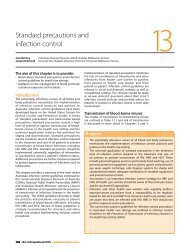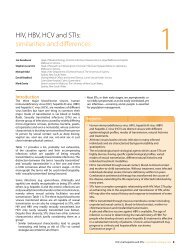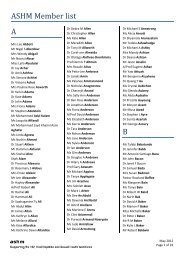B Positive – all you wanted to know about - ASHM
B Positive – all you wanted to know about - ASHM
B Positive – all you wanted to know about - ASHM
Create successful ePaper yourself
Turn your PDF publications into a flip-book with our unique Google optimized e-Paper software.
7 Treatment of chronic hepatitis B virus infection<br />
neuropsychological side effects and other<br />
complications of interferon-based therapy.<br />
for patients treated with pegylated interferon,<br />
frequent (e.g. fortnightly) moni<strong>to</strong>ring is<br />
recommended until the treatment dose<br />
is stabilised. Patients can then reduce the<br />
frequency of their visits <strong>to</strong> every four <strong>to</strong> six<br />
weeks. Particular attention should be paid <strong>to</strong><br />
the full blood count, white cell count differential<br />
and platelet count at each visit, in case dose<br />
adjustments are required.<br />
in patients treated with nucleoside analogues,<br />
moni<strong>to</strong>ring should occur on a three monthly<br />
basis—particularly for patients with advanced<br />
fibrosis or cirrhosis, and for those patients on<br />
antiviral therapy who have a high incidence of<br />
viral resistance. full blood count, liver function<br />
tests and HbV serology (for Hbeag-positive<br />
patients) should be performed at each of<br />
these visits. the optimal frequency for HbV<br />
dna testing remains <strong>to</strong> be determined. threemonthly<br />
HbV dna testing appears appropriate<br />
for patients with high viral resistance rates or<br />
in those for whom the likelihood of clinical<br />
complications due <strong>to</strong> delaying therapy for<br />
resistance is judged <strong>to</strong> be high. the frequency<br />
may be reduced <strong>to</strong> four or six monthly for<br />
patients with low resistance rates and in those<br />
for whom the risk of complications of resistance<br />
is judged <strong>to</strong> be low. 4,16<br />
Antiviral drug resistance<br />
the emergence of antiviral drug resistance<br />
is the major ch<strong>all</strong>enge confronting clinicians<br />
who manage patients with cHb. recently, the<br />
following definition for antiviral resistance<br />
<strong>to</strong> nucleoside analogue treatment was<br />
proposed: a confirmed 10-fold increase in<br />
serum HbV dna level (> 1 log 10 iu/mL) from<br />
nadir following initi<strong>all</strong>y effective treatment<br />
constitutes secondary treatment failure<br />
which, in the absence of poor adherence or<br />
drug substitution, is almost always due <strong>to</strong><br />
the emergence of the drug-resistant HbV<br />
mutants. a rebound in serum HbV dna always<br />
precedes the biochemical and his<strong>to</strong>logical<br />
markers of increased HbV disease activity, and<br />
patients with underlying cirrhosis are at an<br />
increased risk of decompensation following<br />
6 b <strong>Positive</strong> <strong>–</strong> <strong>all</strong> <strong>you</strong> <strong>wanted</strong> <strong>to</strong> <strong>know</strong> <strong>about</strong> hepatitis b: a guide for primary care providers<br />
the emergence of resistance. early diagnosis of<br />
secondary treatment failure and the institution<br />
of appropriate antiviral therapy remain key<br />
<strong>to</strong> preventing hepatic decompensation, liver<br />
failure, death or liver transplantation in patients<br />
who develop drug resistant mutations. 16<br />
Predic<strong>to</strong>rs of lamivudine resistance include<br />
high pre-treatment HbV dna levels, non-asian<br />
ethnicity, male gender and persistent viral<br />
replication with continued antiviral therapy. 1<br />
the molecular characterisation of genotypic<br />
changes that confer resistance is not usu<strong>all</strong>y<br />
performed in clinical practice, and there is no<br />
indication that such labora<strong>to</strong>ry analysis will<br />
be reimbursed by Medicare in the near future.<br />
While the sequencing of HbV drug-resistant<br />
mutations is largely regarded as a research <strong>to</strong>ol<br />
at present, it can provide important information<br />
and influence the selection of the most<br />
appropriate therapeutic antiviral strategy.<br />
in relation <strong>to</strong> reimbursement options by the<br />
Pbs, the management of patients who develop<br />
lamivudine resistance is limited <strong>to</strong> switching<br />
therapy <strong>to</strong> either adefovir or entecavir. However,<br />
the risk of the emergence of subsequent<br />
adefovir or entecavir resistance is much higher<br />
in this cohort of patients than in treatmentnaïve<br />
patients. there is now abundant evidence<br />
that the addition of adefovir <strong>to</strong> lamivudine<br />
therapy, rather than a switch <strong>to</strong> adefovir<br />
monotherapy, is the preferred management<br />
strategy for patients who develop lamivudine<br />
resistance. in those patients who have<br />
been placed on adefovir monotherapy, (for<br />
lamivudine resistance), the development of<br />
resistance <strong>to</strong> adefovir can often be managed<br />
by the re-introduction of lamivudine and the<br />
continuation of adefovir. at present the Pbs<br />
will not provide reimbursement for combined<br />
therapy in this patient group. However, it<br />
is expected that combination therapy with<br />
adefovir and lamivudine for this patient group<br />
only will be approved in the near future.<br />
the molecular virology of HbV viral resistance is<br />
discussed in more detail in chapter 2: Virology:<br />
viral replication and drug resistance.






